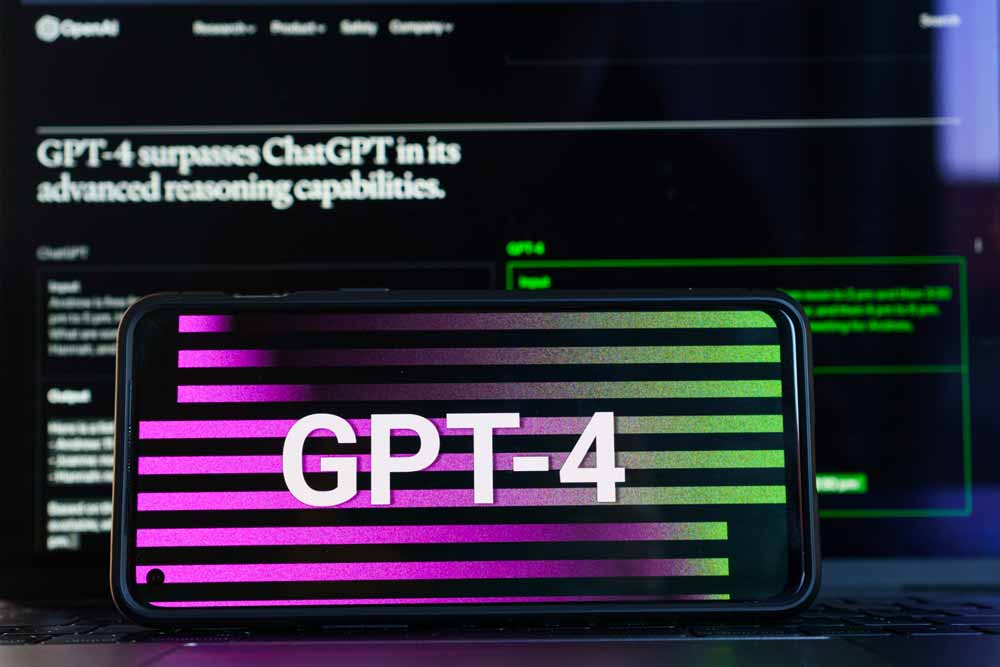Tabella dei contenuti
“Only consciousness separates us from artificial intelligence”: do you think these words were typed by a human being or AI, artificial intelligence? Yes, because technological developments are now so advanced that the Turing test, one of man’s first attempts to measure the degree of artificial intelligence of a computer, devised by Alan Turing in 1950, has been surpassed for years. And GPT4, the latest version presented by OpenAI, the leading chatbot and artificial intelligence company, is exactly proof of this. After all, we have been using artificial intelligence in everyday life for some time now. With ChatGpt it will now be possible to go further and use artificial intelligence chat to positively impact ai marketing in Italy.
But let’s take a step back and start first of all with the definition of chat GPT4. GPT is an acronym for Generative Pretrained Transformer, a kind of “transformer” of language models based on a series of provided data capable of processing the command into textual or multimedia content. In fact, one of the most interesting aspects of Chat GPT4 is precisely its ability to understand text and images. That is, you have the possibility to write with artificial intelligence but you can also use artificial intelligence to generate photos and images. In addition, starting from a diagram, an image, a chart, the new artificial intelligence launched on the market can provide a detailed description of the image or answer questions about the text. And this is already a factor of great importance as it could be useful for those who are visually impaired and could therefore take advantage of this type of technology to get an idea of what is in front of them, for example.
Differences between GPT3 and GPT4
Let’s go into detail and see what the differences are between GPT3 and GPT4. First of all, GPT4 contains 45 gigabytes of training data compared to GPT3’s 17 gigabytes, which means it can provide more accurate results than the previous version. The GPT4 version also has a 40% higher probability of producing real responses and an 82% lower probability of responding to prohibited content. Not only that, in chat GPT4 an advanced security search and monitoring system has been integrated and it has a greater problem-solving capacity, allowing it to solve complex problems with greater precision based on the prompts entered. In addition, GPT4:
- creates and modifies creative texts, scripts, composes songs, even learning the writing style of a particular user, making interactions more engaging and improving the user experience
- generates classifications, captions, analyses starting from an image. A clear example is the photo of 4 ingredients that chat GPT4 can use to suggest certain recipes
- processes more than 25,000 words of text and can therefore be used for the production of articulated and long content
- performs multiple tasks simultaneously and could even be used to automate customer service requests
- allows you to customize advertising content by adapting it to various demographic data
- has advanced reasoning capabilities and uses more data to create sophisticated language models. It can indeed handle textual translation in multiple languages and generate texts that mimic human behavior. This means being able to produce more high-speed content automatically, optimizing time and internal resources for a company.
The deep learning approach for new linguistic models
The learning of data by artificial intelligence, what is defined as deep learning artificial intelligence, allows the creation of more sophisticated language models and in fact GPT technology, as anticipated in the previous paragraph, selects words from the database and inserts them correctly into the context of any sentence. And that’s why thanks to machine learning and artificial intelligence it is much easier to create new texts, also useful for marketing purposes!
What is artificial intelligence
But in fact, what is artificial intelligence and what are the two main paradigms of artificial intelligence? AI is the branch of computer science that replicates or simulates human intelligence in a machine, so much so that some functions even allow learning, planning, problem solving and decision making. To power AI systems, algorithms or machine learning techniques are used. To better understand the definition of artificial intelligence, however, it is also necessary to delve into the distinction between the two paradigms, that is, to better understand what we mean by weak artificial intelligence and strong artificial intelligence. Weak or narrow artificial intelligence is what we have used until now for internet searches, for voice recognition or voice assistants, to drive a vehicle, for voice recognition. Yet, although it is always artificial intelligence, there are constraints that limit it (which is why it is called “weak”), including the simulation of human behavior based on narrow parameters. The clearest example to explain this is the Siri virtual assistant on iPhone or the use of Google’s Artificial Intelligence virtual assistant. Strong artificial intelligence, on the other hand, is the type of intelligence that mimics human behavior or intelligence and applies its intelligence to solve problems, so much so that in some situations it becomes difficult to distinguish whether the way of thinking or acting is that of a human being or a machine. All this translates into the possibility of talking with artificial intelligence, exploiting an artificial intelligence that writes texts and in general artificial intelligence software also to optimize workflows.
For companies that need to produce a lot of textual content, AI marketing is now the new frontier of organizing conversations, from those rich in technical details and operational support (already revolutionized by the arrival of chatbots) to commercial and brand identity ones, more differentiating and in need of generative intelligence.
A functional tool like GPT4 will allow editorial staff and copywriters (now labeled as content factories) to optimize and schedule the creation of daily content, up to, theoretically, even the most complex texts.
Ai marketing: how it works and why it matters
In practice, this new era of artificial intelligence can be exploited to plan more effective communication strategies, and to convert users with a personalized call-to-action. In other words, AI provides useful tools to intercept the target through data collection and its transformation into information and then strategy planning. All this leads to a great opportunity for the company: the possibility of creating promotional campaigns based on user behavior. Just think of some applications that have been used in marketing for some time, from voice search to content management, from artificial intelligence chatbots to virtual assistants or programmatic advertising.
Alternatives to ChatGPT4: The best tools on the market to generate AI content
Here is an overview of the Chatgpt alternatives and not only present on the market sector by sector.
Image generation software
- Midjourney: requires registration for the Beta version through the use of Discord. Very convenient for generating a particular image that you can’t find already available on the web.
- Dall-E 2: software created by OpenAI, which allows both to create images starting from a description provided by the user, and to modify pre-existing images.
- eADV: works like ChatGPT but, instead of a textual output, it returns a visual one. Like DALL-E, but with the advantage of being able to talk to AI to modify or improve the image generated through textual input.
- Dawn AI: application for creating cartoon-style avatars. This app, downloadable from any digital store, allows you to create really well-made and faithful avatars.
- Lensa AI: is an app available for both iOS and Android. Its functionality does not differ from that of Dawn AI, but in this case it is not possible to access the service for free.
AI tools to generate audio and video
- VoicePen AI: convert audio content into blog posts using artificial intelligence.
- Krisp: AI tool to remove background voices, noise and echo from calls.
- Uber Duck: tool capable of creating digital versions of any voice and, above all, of creating vocal clips with famous rapper voices.
- Beatoven: AI tool for creating personalized royalty-free music.
- Cleanvoice: AI tool for automatic editing of podcast episodes.
- Vidyo: AI tool for creating short videos from long content.
- Otter: artificial intelligence tool, only in English, for capturing and sharing insights from meetings.
Copy and artificial intelligence tools useful for creating content:
- Contents: together with Jasper, it is one of the leading platforms in the sector, the offer is divided into 3 macro areas: Ideation, Creation, Transformation. Contents is the perfect solution to exploit artificial intelligence for analysis on industry trends, for the creation of editorial content or designed to enhance products for any type of e-commerce, up to the generation of texts starting from audio and vice versa, in a totally automatic way or by using human support for further control.
- Jasper.ai: tool for creating copy, images, emails and video scripts. One of the most powerful and appreciated tools on the market, also used by communication giants such as Canta, Zoom, Deloitte, Zendesk and many others.
- Copy.ai: AI tool for generating copy that increases conversions.
- CopyMonkey: AI tool for optimizing Amazon listings in seconds.
- Unbounce Smart Copy: AI tool for writing large-scale emails.
- PDPmachine: tool for creating product pages in series using AI. Very effective in English to have interesting drafts.
- Geniussheet: query your data on Gsheets in text form to extract what you need.
- ShareGPT: find the best prompts for ChatGPT and always new ideas.
Of course, if on the one hand artificial intelligence is undoubtedly sophisticated and constantly enriching today, on the other hand it is equally true that it is always the human mind that governs. What does this mean? It means that if AI can support strategic planning at the marketing level and beyond, it will then be necessary for there to be human input and cognition to add distinctive value to communication processes and content: we must not forget that the interlocutor and consumer are people.
Chatbots and artificial intelligence in general are today the most challenging technological elements for setting up digital marketing in an innovative way.
Do you need support for your digital marketing? Key One can help you:
- Establish your market positioning
- Identify and analyze your brand
- Promote your business with SEO-oriented content, editorial plans, advertising campaigns set up according to a targeted strategy, posts on different social channels
- Measure results obtained through KPIs and reports.










